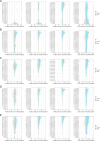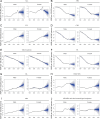Hematological malignancy burden in mainland China and Taiwan from 1990 to 2021 and decadal projections: Insights from the global burden of disease study 2021
- PMID: 40690460
- PMCID: PMC12279097
- DOI: 10.1371/journal.pone.0328526
Hematological malignancy burden in mainland China and Taiwan from 1990 to 2021 and decadal projections: Insights from the global burden of disease study 2021
Abstract
Objectives: Hematological malignancies (HMs) pose a severe threat to human health and contribute substantially to the disease burden in mainland China and Taiwan. Therefore, understanding their burden is crucial for informed decision-making and the effective allocation of healthcare resources.
Methods: This study utilized the latest data from the Global Burden of Disease 2021 study to describe the epidemiological indices of HMs in mainland China and Taiwan from 1990 to 2021. The future disease burden was projected for the next decade using the Bayesian age-period cohort (BAPC) model.
Results: Between 1990 and 2021, mainland China experienced an increase in the prevalence and incidence of leukemia and lymphoma, while the mortality and disability-adjusted life years (DALYs) for these diseases declined. Conversely, Taiwan witnessed an overall increase in the prevalence, incidence, mortality, and DALYs of leukemia over the same period. Additionally, multiple myeloma (MM), myelodysplastic/myeloproliferative neoplasms, and other hematopoietic neoplasms have shown significant increases in prevalence, incidence, mortality, and DALYs in China. While the disease burden of myeloid leukemia decreased in mainland China, that of lymphoid neoplasms (including leukemia, lymphoma, and MM) increased, which was not observed in Taiwan. Predictions from the BAPC model suggest that the incidence of several lymphoid neoplasms and MM is expected to increase in mainland China and Taiwan.
Conclusions: Taiwan continues to face greater challenges in managing HMs compared to mainland China. MM imposes a significant burden on the Chinese population. The findings of this study provide valuable epidemiological insights for optimizing the allocation of medical resources.
Copyright: © 2025 Fu et al. This is an open access article distributed under the terms of the Creative Commons Attribution License, which permits unrestricted use, distribution, and reproduction in any medium, provided the original author and source are credited.
Conflict of interest statement
The authors have declared that no competing interests exist.
Figures






Similar articles
-
Burden of knee osteoarthritis in China and globally: 1990-2045.BMC Musculoskelet Disord. 2025 Jul 1;26(1):582. doi: 10.1186/s12891-025-08858-8. BMC Musculoskelet Disord. 2025. PMID: 40598022 Free PMC article.
-
Burden of hematologic malignancies in China from 1990 to 2021: analysis from the Global Burden of Disease Study 2021.BMC Public Health. 2025 Jul 2;25(1):2280. doi: 10.1186/s12889-025-23469-7. BMC Public Health. 2025. PMID: 40604781 Free PMC article.
-
Incidence and disability-adjusted life-years of infective endocarditis in China from 1990 to 2021: comparison with G20 based on the Global Burden of Disease Study 2021.BMJ Open. 2025 Jul 6;15(7):e094490. doi: 10.1136/bmjopen-2024-094490. BMJ Open. 2025. PMID: 40623737 Free PMC article.
-
Global and China burden of ectopic pregnancy (1990-2021): Trends, patterns, and future projections.J Obstet Gynaecol Res. 2025 Jul;51(7):e70005. doi: 10.1111/jog.70005. J Obstet Gynaecol Res. 2025. PMID: 40678904
-
Disease burden of COPD in the Chinese population: a systematic review.Ther Adv Respir Dis. 2023 Jan-Dec;17:17534666231218899. doi: 10.1177/17534666231218899. Ther Adv Respir Dis. 2023. PMID: 38146618 Free PMC article.
References
-
- Shadman M. Diagnosis and treatment of chronic lymphocytic leukemia: a review. JAMA. 2023;329(11):918–32. - PubMed
MeSH terms
LinkOut - more resources
Full Text Sources

